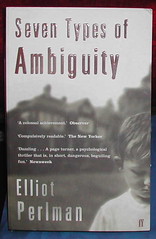
My reading has become a lot slower recently, ever since I decided it would be good for me if every alternate book was in French. By reading Seven Types of Ambiguity I haven’t increased my rate at all: it has 607 pages. I bought the book ages ago and it has been sitting sadly on my shelf waiting its turn, so what could I do?
The title is taken directly from a book of the same name by William Empson. It tells of the events leading up to and the consequences of the main character's abduction of the son of an ex-girlfriend. It describes it using seven different narrators, seven people with slightly different views on what happened, and on their relationships with each other.
Although the seven characters were very different, it was their views on the events that underlined their difference. Barbara Kingsolver uses the same technique of using multiple narrators in The Poisonwood Bible but the difference between characters there is more evident in the style of writing. Here the style is fairly consistent throughout and lends yet another aspect of ambiguity because each time the narrator is changed, it takes a while to work out who it is.
Perlman is apparently a lawyer, or has been one, which may explain the rather lengthy courtroom passages. The discussions of legal points leave me cold and remind me of other lawyers turned novelist. The only other disappointing aspect was the slight preachiness in attitude to politics in healthcare, and to Joe, his stockbroker lifestyle, and the culture of greed. For me these sections give the impression having been added in later to make sure we get the message, and seem unnecessary (described in the Guardian review "Seven Types of Moralising"). I felt Joe himslef was something of a caricature but perhaps not. I don’t think I know any stockbrokers.
The ambiguity does continue right up to the end. Normally this would bother my literal mind which likes everything to be tied up carefully, but in this case I feel I was more interested in the characters and their relationships than in the plot. There are too some passages which will remain with me for a long time:
“there is a definite warning sign for people living by themselves - the salad dressing stops appearing in the salad, then the tomatoes, then the salad itself. Then you're just left with a bowl which, sooner or later, you fill with cereal and milk and then - for the hell of it - you start to add a little scotch to the milk.”
"is it mad to love in spite of the evidence... or just necessary?"
Describing the children Simon taught: “the noisy ones, the naughty ones, the scraggly ones with one jumper and two shirts, the fast ones in runners, the pretty ones with skinny legs who followed him everywhere and the very quiet ones who still were not used to having been born”
"There is an ambiguity of human relationships, for instance. A relationship between two people, just like a sequence of words, is ambiguous if it is open to different interpretations. And if two people do have differing views about their relationship - I don't just mean about its state, I mean about its very nature - then that difference can affect the entire course of their lives."
It’s a very readable and even compulsive book. I recommend it.
Now this is a book I have to read if only for "for the hell of it - you start to add a little scotch to the milk.”
ReplyDeleteAs to love. It finds you, you don't find it so you might as well let it stay as long as it wants.
There are quite a few lovely phrases throughout, or at least I thought so. If you do read, do let me know what you think of it.
ReplyDelete